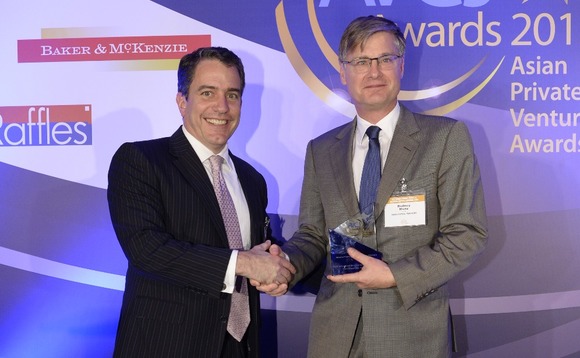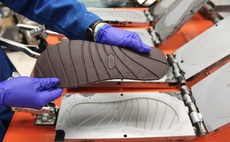
AVCJ Awards 2015: Operational Value Add: ECO Industrial Environmental Engineering

Navis Capital Partners saw in ECO Industrial Environmental Engineering a potential leader in the hazardous waste management industry. Getting there was tougher than expected
"Average management teams are essentially an enemy of alpha," says Nick Bloy, managing partner at Navis Capital Partners. "We learned that you shouldn't tolerate mediocre or even average management - you will generate to beta, and you aren't paid to do that. Either management becomes good quickly or you have to replace them, and it's a painful transition."
Navis' investment in ECO Industrial Environmental Engineering was very much a holding period of two halves. The first, between 2007 and 2011, was characterized by frustration with a management team that manifestly failed to deliver. The second, which culminated in a trade sale earlier this year, involved new leadership, better governance, and a turnaround that at one point barely seemed possible.
It was, Bloy adds, a lesson that "if you have a humane reaction to people and place hope in the notion that they will get better, in general it's a recipe for value destruction."
We learned that you shouldn't tolerate mediocre or even average management - you will generate to beta, and you aren't paid to do that - Nick Bloy
When the private equity firm came across Singapore-based ECO Industrial in 2007, it was an unspectacular player in a waste management industry that had significant growth potential. Navis heard about the company because the founders, a group of local entrepreneurs, were considering an IPO. However, as the business lacked scale, joining the Singapore Exchange brought with it the danger of minimal investor interest, low share turnover, and zero liquidity.
Navis structured a private buyout of all bar one of the existing investors, committing $45.4 million from its fifth fund. The remaining investor was the CEO, who had around a 5% stake and was allocated performance-based incentives that could translate into twice as much equity. He was a dominant personality and Navis was reluctant to upset the balance.
"We felt we could influence him to do the right thing by virtue of constant persuasion and pressure," Bloy says. "But we were reluctant to remove him because we felt that the rest of the organization might be a bit rudderless. The team was very beholden to him."
Room to improve
ECO Industrial was attractive because it held one of only four licenses granted by the Singapore government for treatment of hazardous waste material. The company also had a strong customer base, suitable technical capabilities, and in Navis' view, the potential to become a market leader that grew in tandem with expanding manufacturing output and resultant waste volumes.
However, the company was unfocused, with a reputation for being lax on governance and regulatory compliance. It was highly dependent on the general waste management space - taking woodchips created by land maintenance and turning them into energy, recycling plastic bottles - which is a highly commoditized business with minimal barriers to entry and offers low returns.
Furthermore, ECO Industrial was riddled with inefficiencies, from operating two separate sites in different parts of Singapore to running unprofitable incinerators.
"There was one cogeneration woodchip-fired power plant but we had to pay for the woodchips, whereas with a hazardous waste cogeneration plant you are paid for taking the waste and for producing electricity and steam from it," recalls Rick Reidinger, who was brought in as CEO of the company in 2011 and stayed in the role after Navis exited. "Another incinerator didn't produce power and steam, and was just small and fairly inefficient."
The investment was predicated on tightening up operations and moving away from general waste management and invest the capital tied up in that side of the business in hazardous waste services. Not only did local licensing make it a difficult segment to enter, but it was also capital intensive, highly regulated, and populated by sophisticated and demanding customers such as Chevron, Exxon Mobil, and GlaxoSmithKline.
An early win came in 2008 when ECO Industrial won a 10-year exclusive contract from the Public Utilities Board of Singapore to treat sewage sludge, which required a dedicated incineration facility. However, the global financial crisis hit manufacturing, which turn cut back hazardous waste production. This was followed by continuing problems with the CEO, who turned out to be weak on strategic and compliance.
The situation came to a head in 2011 when it emerged that the CEO's behavior was more egregious than anyone had anticipated.
ECO Industrial's sewage treatment facility is equipped with a penstock, or sluice, to ensure untreated waste does not enter the sewage system; if any is detected, the gate comes down to stem the flow. The CEO discovered that removing the device and dropping it into a bucket of clean water within 30 seconds tricked the sensor and waste could enter the system unchecked.
It was a classic corner-cutting maneuver, essentially allowing ECO Industrial to charge for waste water coming in and incur no cost for treating it, before pumping it straight back out again. "It put the very raison d'être of the business at risk," says Bloy. "The regulators could have shut us down and never allowed us to re-open. It could been totally disastrous."
The CEO was fired for cause and Navis bought back his stake in the company at a steep discount by way of a penalty. ECO Industrial went to the regulators, explained what had happened, and promised to clean up the business. Several other senior management figures were removed around the same time.
Reidinger, who previously served as regional director of AECOM's environmental business unit in Asia, was at the time a portfolio director with Navis responsible for environmental services. Already a board member at ECO Industrial, he was sent in full-time as acting CEO. Reidinger's to-do list included repairing relationships with customers and the regulator, restructuring the management team, and re-engineering the business from a revenue and an operations perspective.
Taking action
Low-value customers were dropped as ECO Industrial vacated general waste management for higher-margin hazardous waste services, while one of the sites was sold off and the S$11 million in proceeds was put towards the industrial waste facility. "We were able to eliminate 10-20% of the manpower with no loss of revenue or important business, because we were closing the low-margin areas," says Reidinger. "This allowed us to invest in the good side of the business."
There were more than a dozen investments in advanced new facilities and upgrades between 2011 and 2015, but the critical point came in 2012 when Navis approved the construction of a large hazardous waste-to-energy plant in order to expand incineration capacity substantially. The capital - Bloy estimates it was in the region of S$20-30 million - came from cash reserves and through some financial leverage, but the real issue was time. It was already year five of the investment.
"When we made that decision we knew it would take 20 months to build the plant and then another year of operation to get utilization up. Any big complex, capital intensive equipment when run at low levels of capacity utilization will have high costs. There's no profit until you reach 60-70% utilization," he adds. "When we pulled the trigger on that we knew we were delaying the exit at least until 2015."
In addition to replacing the two unprofitable incineration plants with high-end cogeneration apparatus, ECO Industrial's solvent recovery processes were improved, contributing to a 38% increase in blended slop oil resale prices, and capacity was expanded. More efficient incineration meant less landfill waste, and steps were taken to ensure that any waste generated went into landfill at reduced cost.
Surplus electricity from incineration was used to support on-site operations, while the logistics system was altered so that truck drivers were paid per trip rather than per hour, resulting in an increased number of trips and consequent cost savings. Drivers also received proper training and each one was certified to drive two types of truck, another efficiency initiative.
Revenue did not go up straight away. After reaching S$44 million in 2008, the figure bobbed around the same mark for five years, before rising to S$56 million in 2014 and an estimated S$66 million for this year. EBITDA followed an even steeper trajectory, rising from S$8 million in 2012 to S$12 million, S$17 million and S$25 million over the following three years. For 2014 and 2015, EBITDA margins also improved, hitting 30% or more for the first time in years.
"Without the new facilities and the re-engineering, we couldn't have done any of this - we couldn't have taken the additional waste because we didn't have the capacity. That took a big investment and a lot of thought, coming up with a cogeneration plant that would actually work," says Reidinger. "Revenue went from S$45 million in 2011 to S$43 million in 2012 because we dropped some customers, but in that first year we went from 325 staff to 230, a more than 30% cut."
By 2014, with volumes ramping up and utilization rates encouraging, Navis began to explore its exit options. A mandate was awarded to boutique investment bank TC Capital towards the end of the year and an investment memorandum was released in February 2015 to approximately 30 strategic investors. This resulted in 15 proposals from groups based in Europe, Japan, Australia, Singapore, Malaysia and the US.
"We didn't open up the process to financial investors, just strategic players, and shortlisted a few based on issues such as price and confidence in closing a deal," says Reidinger. "There were KPIs [key performance indicators] that we had run the business on, so it was very clear why performance was improving. We got down to the final two bidders in May or June and within a month an agreement was signed with Beijing Capital Group (BCG)."
A logical buyer
BCG, which operates wastewater treatment, water construction and real estate businesses in China, saw ECO Industrial as platform from which it could expand into the Southeast Asia waste management market. The company had already made its ambitions plain a year earlier, outmuscling several rival bidders to secure Transpacific Industries Group's (TPI) New Zealand waste management business for NZ$950 million ($794 million). Reidinger was suitably impressed by the group's due diligence process and plans that he agreed to stay on as CEO of ECO Industrial.
Bloy agrees that it makes sense for any group seeking a foothold in Southeast Asia to start in Singapore, the most complex and demanding waste management market in the region. And ECO Industrial is one of few fully-licensed operators likely to become available. At the same time, though, there is a strong Chinese rationale to BCG's acquisition.
"There are 40 cities in China that are the size of Singapore and they will develop the needs of Singapore over the next 10-20 years. All of them will require a hazardous waste management solution," he says. "BCG can take ECO Industrial and replicate it in every Chinese city that needs this kind of capability."
Navis received S$246 million ($179 million) for its controlling interest in the business. While the gross IRR came in at 20% - reflecting the longer-than-usual holding period - the return multiple was a healthy 3.8x.
"It didn't look good for the first three or four years, but most LPs understand that you can't prematurely judge a good or bad investment. That is one of the advantage of private equity; it gives you the staying power to move through macro and micro problems," Bloy adds. "There were some very painful moments and some stress, but we learned a great deal from ECO Industrial and it has left us better-informed on more recent investments."
Latest News
Asian GPs slow implementation of ESG policies - survey
Asia-based private equity firms are assigning more dedicated resources to environment, social, and governance (ESG) programmes, but policy changes have slowed in the past 12 months, in part due to concerns raised internally and by LPs, according to a...
Singapore fintech start-up LXA gets $10m seed round
New Enterprise Associates (NEA) has led a USD 10m seed round for Singapore’s LXA, a financial technology start-up launched by a former Asia senior executive at The Blackstone Group.
India's InCred announces $60m round, claims unicorn status
Indian non-bank lender InCred Financial Services said it has received INR 5bn (USD 60m) at a valuation of at least USD 1bn from unnamed investors including “a global private equity fund.”
Insight leads $50m round for Australia's Roller
Insight Partners has led a USD 50m round for Australia’s Roller, a venue management software provider specializing in family fun parks.








